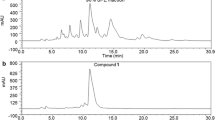Abstract
This study highlights the importance of alpha-glucosidase inhibitors as mechanisms for endophyte-mediated resistance to insect pests. One of the major benefits which endophytes confer on plants is providing resistance against insect pests. This built-in defense mechanism of the plant can be used for exploring ecofriendly strategies for pest control. In the present study, 34 endophytic fungi were isolated from Tinospora cordifolia and screened for their ability to produce alpha-glucosidase inhibitors. Maximum inhibitory activity was observed in an isolate from T. cordifolia (TN-9S), identified to be Cladosporium sp. The inhibitor was purified using chromatographic techniques. The insecticidal activity of the purified inhibitor was evaluated against Spodoptera litura. The inhibitor induced a significant mortality in the larvae of S. litura and adversely affected its survival and development. It also inhibited the activity of α-glycosidases in vivo in the gut of the larvae. The purified inhibitor was determined to be a phenolic compound with amine groups, demonstrating a noncompetitive type of inhibition in vitro. The production of the inhibitor was optimized. Response surface methodology (RSM) analysis revealed a significant interaction between dextrose and malt extract, with first-order effect of pH.













Similar content being viewed by others
References
Maxmen, A. (2013). Nature, 501, 15–17.
Strobel, G. A. (2003). Microbes and Infection, 5, 535–544.
Tan, R. X., & Zou, W. X. (2001). Natural Product Reports, 18, 448–459.
Azevedo, J. L., Jr., Maccheroni, W., Pereira, J. O., & Araujo, W. L. (2000). Electronic Journal of Biotechnology, 3, 15–16.
Prestidge, R. A., & Gallagher, R. T. (1988). Ecological Entomology, 13, 429–435.
Bacon, C.W., & Hills, N.S. (1996). Endophytic fungi in grasses and woody plants. In Reddin S.C., & Carris L.M. (eds.), St. Paul: American Phytopathologycal Society Press, pp. 155–178.
Franco, O. L., Rigden, D. J., Melo, F. R., Bloch, C., Jr., Silva, C. P., & Grossi de SaÂ, M. F. (2000). European Journal of Biochemistry, 267, 1466–1473.
Gatehouse, J. A. (2011). Current Protein and Peptide Science, 12(5), 409–416.
Mehrabadi, M., Bandani, A. R., Mehrabadi, R., & Alizadeh, H. (2012). Pesticide Biochemistry and Physiology, 102, 220–228.
Carlini, C. R., & Grossi-de-Sá, M. F. (2002). Toxicon, 40(11), 1515–1539.
Nair, S. S., kavrekar, V., & Mishri, A. (2013). The European Journal of Experimental Biology, 3(1), 128–132.
Bischoff, H., Puls, W., Karause, H. P., Schutt, H., & Thomas, G. (1985). Diabetes Research and Clinical Practice, 1, 53–62.
Thakur, A., Kaur, S., Kaur, A., & Singh, V. (2012). Biocontrol Science and Technology, 22, 151–161.
Rajalakshmi, M., Eliza, J., Priya, C. E., Nirmala, A., & Daisy, P. (2009). African Journal of Pharmacy and Pharmacology, 3(5), 171–180.
Singh, B., Thakur, A., Chadha, B. S., Kaur, S., & Kaur, A. (2012). Applied Biochemistry and Biotechnology, 168, 991–1002.
Bachhawat, A., Shihabudeen, M. S., & Thirumurugan, K. (2011). International Journal of Pharmacy and Pharmaceutical Sciences, 3, 267–274.
Larone, D. H. (2002). Medically important fungi: a guide to identification (4th ed.). Washington: ASM.
Sharma, M., Chadha, B. S., Kaur, M., Ghatora, S. K., & Saini, H. S. (2008). Letters in Applied Microbiology, 46, 526–535.
Tamura, K., Peterson, D., Peterson, N., Stecher, G., Nei, M., & Kumar, S. (2011). Molecular and Biological Evolution, 28, 2731–2739.
Koul, O., Shankar, J. S., Mehta, N., Taneja, S. C., Tripathi, A. K., & Dhar, K. L. (1997). Journal of Applied Entomology, 121, 245–248.
Bernfeld, P. (1955). Methods in enzymology vol. 1. In Colowick S.P., & Kaplan, N.O. (eds.), NY: Academic.
Ferreira, C., & Terra, W. R. (1983). Biochemical Journal, 213(1), 43–51.
Waksmundzka-hanjos, M., Sherma, J., & Kowalska, T. (2008). Thin layer chromatography in phytochemistry. Boca Raton: CRC.
Scmidt, D. D., Frommer, W., Mullar, L., Junge, B., Wingender, W., & Truscheit, E. (1977). Naturwissenschaften, 64, 535–536.
Scmidt, D. D., Mullar, L., & Trucheit, E. (1979). Naturwissenschaften, 66, 584–585.
Murao, S., & Miyata, S. (1980). Agricultural and Biological Chemistry, 44, 219–221.
Ezure, Y., Murao, S., Miyazaki, K., & Kawamata, M. (1985). Agricultural and Biological Chemistry, 49, 1119–1125.
Ingavat, N., Dobriener, J., Wiyakrutta, S., Mahidol, C., Ruchirawat, S., & Kittakoop, P. (2009). Journal of Natural Products, 72, 2049–2052.
Dewi, R. T., Iskandar, Y. M., Hanafi, M., Karnado, L. B. S., Angelina, M., Dewijanti, I. D., & Banjajarnmohar, S. D. S. (2007). Pakistan Journal of Biochemistry, 6, 465–471.
Mun’im, A., Ramdhan, M. G., & Soemiati, A. (2013). International Research Journal of Pharmacy, 4(5), 128–131.
Ramdanis, R., Soemiati, A., & Mun’im, A. (2012). International Journal of Medicinal and Aromatic Plants, 2, 447–452.
Artanti, N., Tachibana, S., Kardani, L. B. S., & Sukiman, H. (2012). Pakistan Journal of Biological Sciences, 15(14), 673–679.
Saito, N. (1982). Journal of Biological Chemistry, 257, 3120–3125.
Singh, H., Dixit, S., Verma, P. C., & Singh, P. K. (2014). Journal of Agricultural and Food Chemistry, 262(12), 2588–2594.
Mayur, B., Sandesh, S., Shruti, S., & Sung, S. (2010). Journal of Medicinal Plants Research, 4(15), 1547–1553.
Kim, S. D., & Nho, H. J. (2004). Journal of Microbiology, 42(3), 223–227.
Matsui, T., Ebuchi, S., Fukui, K., Matsugano, K., Terahara, N., & Mtsumoto, K. (2004). Bioscience, Biotechnology, and Biochemistry, 68(11), 2239–2246.
Acknowledgments
One of the authors, Bahaderjeet Singh, acknowledges the grant of fellowship under UPE (University with Potential for Excellence) scheme of the University Grants Commission, New Delhi, India.
Author information
Authors and Affiliations
Corresponding author
Rights and permissions
About this article
Cite this article
Singh, B., Kaur, T., Kaur, S. et al. An Alpha-Glucosidase Inhibitor from an Endophytic Cladosporium sp. with Potential as a Biocontrol Agent. Appl Biochem Biotechnol 175, 2020–2034 (2015). https://doi.org/10.1007/s12010-014-1325-0
Received:
Accepted:
Published:
Issue Date:
DOI: https://doi.org/10.1007/s12010-014-1325-0




